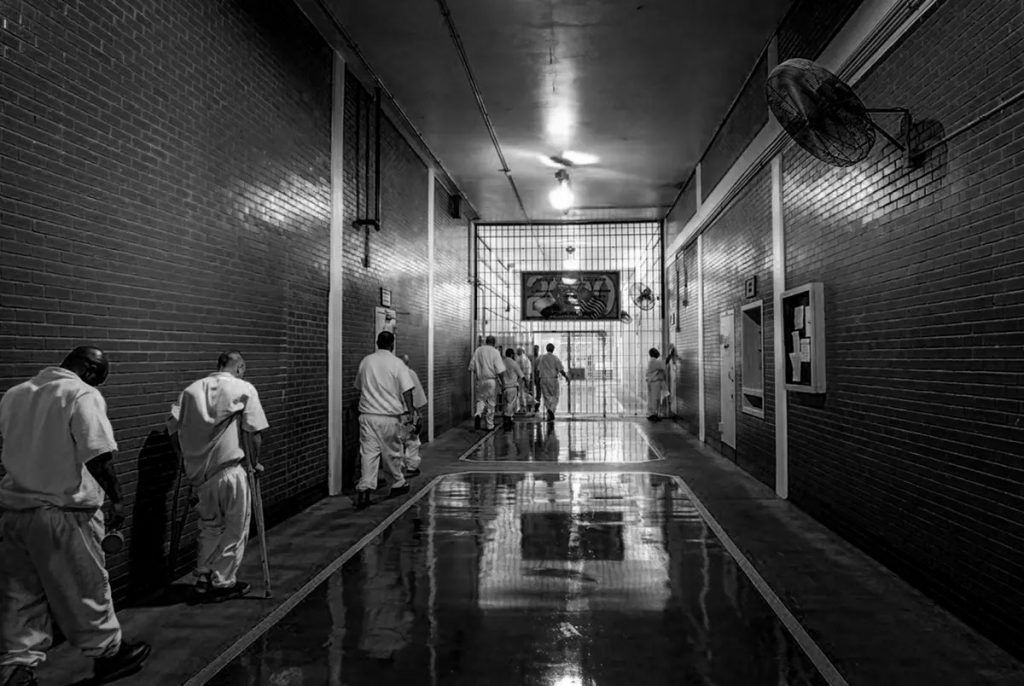By Alejandra Jimenez – RHS Intern

“History always repeats itself. We can only learn to hold it differently.” – Ari B. Cofer (Author of Paper Girl and the Knives that Made Her)
In an age where topics of conversation are scrutinized on a scale of least to most political, the subject of prison reform is rarely welcomed. But, as the climate warms, for the good of prisoners, guards, and state and national coffers, we will need to change our prison system. Avoiding such matters may be labeled prudence by some, or complicity by others, but regardless of one’s stance on the topic, the following paragraphs provide insight into the relationship between extreme heat and the realities of the incarcerated, as well as the effects that an ever-changing climate has on the prison industrial complex.
Jaron Browne, communications organizer and author of Race, Poverty & the Environment, explained how the ways in which we treat the incarcerated constitute an era of oppressive treatment. At least since the end of the Civil War in 1865, many prisons have not fully considered the safety implications on the people residing within them. This means that inmate cells rarely have air conditioning and have too few windows to provide adequate ventilation and circulation of air during heat waves. They also have little to no access to the natural world. Individuals such as Joshua Hieronymus, one of many inmates who have felt nature-deprived, shared during a 2018 interview with Austin’s PBS, “I can’t even put into words how much of a weight was lifted off me, just being able to get my hands in the dirt.”
In an article by The Marshall Project, New York University clinical professor of emergency medicine, Dr. Susi Vassallo, gave an overview of how bodies regulate themselves in extreme temperatures. Naturally, a person’s body will sweat and dilate blood vessels as part of a self-cooling mechanism. But “when the humidity is really high, the sweat can’t evaporate…It just rolls off your body without cooling it… The cells of the body start to cook and fall apart.” Inmates experience this as they continuously pass out in their cells due to scorching heat, and are found dead, hot to the touch, with body temperatures as high as 109.9 degrees Fahrenheit.
In a letter to PBS science series NOVA, inmate Sherrard O. Williams shared the realities of many convicts from across the country who are left to face the excruciating effects of a lingering summer heatwave. He recalled how inmates “would walk around with soaked wet clothes,” and those who were “locked in a cell 23 hrs. of the day would flood their prison cell floors and lay down in the water.” Writing from first-hand experience, Williams recounted his time spent in solitary confinement- better known to the inmates at the John B. Connally Unit in Kennedy, Texas, as the “devil’s den,”- and feeling as though he “could only sleep for minutes at a time & wake up in pools of my own sweat.”
According to 2017 statistics by The University of Texas Medical Branch and the Texas Department of Criminal Justice, there are an estimated 145,167 people incarcerated in the State of Texas; of which 30,678 are prescribed psychotropic medication and 3,241 are over the age of sixty-five. Featured in NOVA’s article, Dr. Vassallo explained how one of the side effects of such medication is that it makes an individual “four times more likely to die of heat-related complications” as it hinders the rate at which the body is able to self-regulate. International climate expert and 2013 President of the American Meteorological Society, Dr. Marshall Shepherd, similarly stressed the severity of this heightened thermal vulnerability as he posed the following scenario: “Imagine being in a prison environment under a heatwave that’s been lingering for a week or two, and the nighttime temperatures aren’t getting too cool… That’s when you start seeing heat-related trauma.” Being witness to the delirium, agony, seizing, and convulsing that arise from heat-stroke victims, inmates diagnosed with mental health illnesses and comorbidities stop taking their medication, which as a result increases the likelihood of suicide and psychotic breaks. In doing so, not only is the safety of other convicts put at stake but that of correctional employees as well.
Prisoners are among the most vulnerable in terms of limited mobility and social isolation. This has prevented even the most basic forms of adaptation – such as basic temperature control. But being confined within a facility away from society for an indefinite amount of time is the punishment, not subjecting people to cruel environments and conditions. Living in an ongoing and worsening climate crisis, providing an air-conditioned environment to a packed facility is not a luxury, it is a necessity. As Texas inmate, Marc Garrett, said during an interview with Austin PBS, “The conditions of confinement are, at a bare minimum, expected to be livable. Not Marriott or Hyatt Regency. Livable.” Incarcerated individuals should bear the protection of having the quality of their health guaranteed upon both entrance and exit.
Garrett is not alone in this as people like Dr. Vassallo, in touring a minimum-security facility reported, “Standing in that cell… that’s a level of stifling I’ve never experienced.” Head of the state correctional officer union, Lance Lowry, impartially elaborates on the gravity of inmates’ living conditions by declaring, “I don’t have love for these people… but the incarceration is their punishment, not cooking them to death.”
The major problem underlying the policy solutions is the multitude of jurisdictions involved. Kelli Bush, director of the Sustainability in Prisons Project, contended that “The key challenge to prison sustainability is high incarceration rates.” Incarcerating fewer people would loosen tight budgets, decrease incentives for industrial development, and lead to a reduction of the goods and materials produced for the maintenance of prisons, which all require the use of fossil fuels. Achieving equilibrium in the way we go about the evolution of our systems of governance is a defining factor for whether this portion of our history will mirror the conditions of convict leasing in the post-emancipation South or whether it will be made anew.
Resources for further reading
“In the Eye of the Storm: When Hurricanes Impact Prisons and Jails,” Prison Legal News, last modified May 17, 2018, https://www.prisonlegalnews.org/news/2018/may/17/eye-storm-when-hurricanes-impact-prisons-and-jails/. Date accessed, March 2, 2022.
“Locked into Emissions: How Mass Incarceration Contributes to Climate Change,” Sage Journals, last modified November 25, 2020, %20have%20numerous%20implications,significant%20increases%20in%20industrial%20emissions. Date accessed, March 6, 2022.
“Rooted in Slavery: Prison Labor Exploitation,” JSTOR, last modified Spring 2007, https://www.jstor.org/stable/41555136. Date accessed, March 8, 2022.
“Incarcerated People Remain Vulnerable to the Worst Ravages of a Warming World,” NOVA, last modified December 5, 2018, https://www.pbs.org/wgbh/nova/article/climate-change-mass-incarceration-prison/. Date accessed, March 8, 2022.
“Boiling Behind Bars,” The Intercept, last modified February 12, 2022, https://theintercept.com/2022/02/12/prisons-texas-heat-air-conditioning-climate-crisis/. Date accessed, February 25, 2022.
“Cooking Them to Death: The Lethal Toll of Hot Prions,” The Marshall Project, last modified October 11, 2007, https://www.themarshallproject.org/2017/10/11/cooking-them-to-death-the-lethal-toll-of-hot-prisons?utm_medium=email&utm_campaign=share-tools&utm_source=email&utm_content=post-top. Date accessed, February 28, 2022.
“No Justice, No Resilience: Prison Abolition As Disaster Mitigation in an Era of Climate Change,” University of Texas Libraries, last modified December 3, 2021, https://www.liebertpub.com/doi/full/10.1089/env.2021.0020. Date accessed, March 3, 2022
“Thermal (In)equity and incarceration: A necessary nexus for geographers,” Sage Journals, last modified December 3, 2021, https://journals.sagepub.com/doi/full/10.1177/25148486211063488. Date accessed, March 13, 2022.
“Texas spent $7 million to fight against A/C in a prison. It may only cost $4 million to install,” THE TEXAS TRIBUNE, last modified August 29, 2018, https://www.texastribune.org/2018/08/29/texas-prison-heat-air-conditioning-cost-drop/. Date accessed, March 24, 2022.
